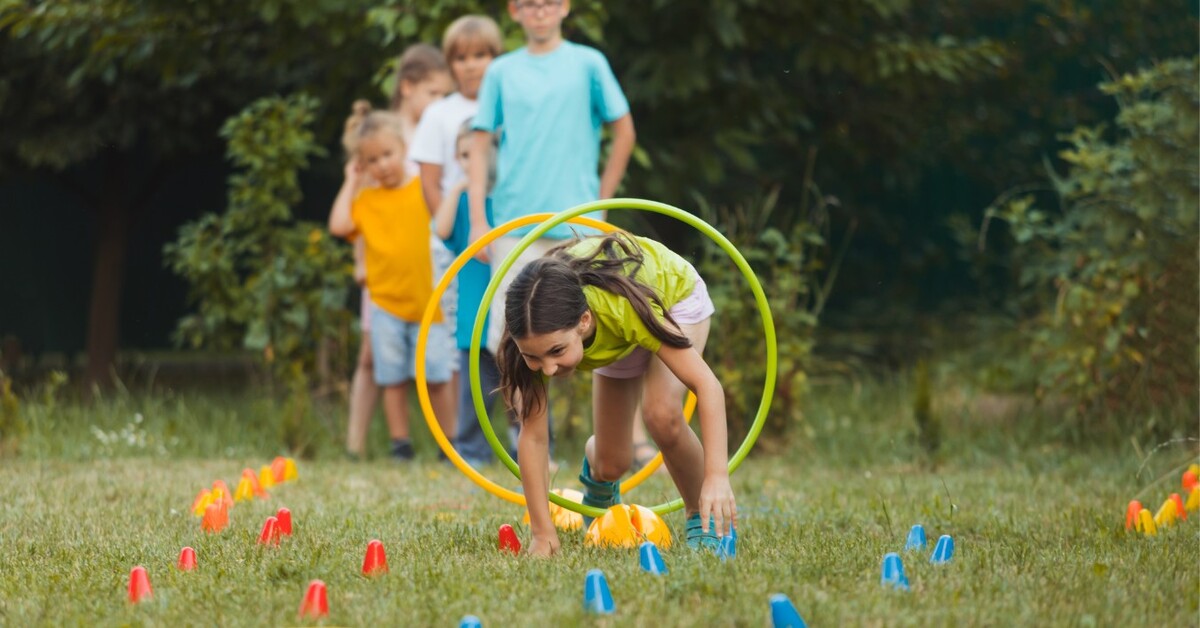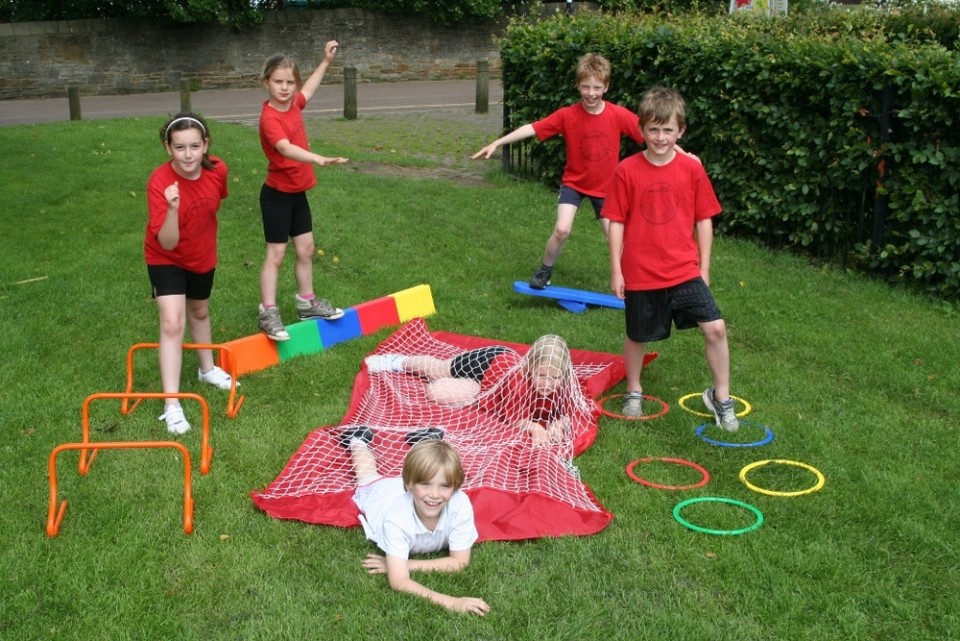
Obstacle course for kids – Effective teaching method
Forget flashcards and lectures – obstacle course is emerging as a fun and effective way to teach kids! These action-packed challenges aren’t just about giggles and getting muddy; they’re secretly unlocking a treasure trove of learning opportunities. Let’s delve into how obstacle course can transform playtime into a powerful teaching method, boosting your child’s development in surprising ways!

What is Obstacle course?
An obstacle course is a series of challenging physical obstacles that an individual, team, or animal must navigate, usually while being timed. It’s a test of speed, endurance, agility, and sometimes even mental problem-solving skills.
Here are some key features of obstacle courses:
- Variety of Obstacles: They can include things like walls to climb over, tunnels to crawl through, hurdles to jump, balance beams to walk across, and ropes to swing on. The specific obstacles can vary depending on the purpose of the course (military training, fitness competition, etc.).
- Challenge by Design: The obstacles are designed to test different physical abilities and push participants to their limits.
- Timed Runs: In many cases, the course is timed, and the goal is to complete it as quickly as possible.
There are many different applications for obstacle courses:
- Military Training: Obstacle courses are a common part of military training, helping soldiers develop the agility and physical fitness needed for combat.
- Fitness Competitions: Obstacle course races have become increasingly popular, testing the fitness and determination of participants.
- Amusement Parks: Many amusement parks have obstacle courses designed for children or adults, offering a fun and challenging activity.
- Team Building Exercises: Obstacle courses can be used as team-building exercises, encouraging communication and collaboration.
Obstacle course fun for kids: Exploring different types

Obstacle courses are a fantastic way for kids to burn energy, develop gross motor skills, and have a blast! But with so many options, choosing the right one can be tricky. Here’s a breakdown of different types of obstacle courses perfect for kids of various ages and interests:
1. Backyard Bonanza Obstacle course:
- Suitable for: All ages!
- Materials: Household items and your imagination!
- Obstacle Ideas:
- Crawling Challenge: Utilize blankets or pillows for a soft tunnel, or use chairs to create a low tunnel.
- Hurdles: Use pool noodles, rope, or even laundry baskets turned upside down.
- Balance Beam: Plank a board on the ground or use a low wall.
- Beanbag Toss: Set up buckets or boxes as targets for throwing beanbags or balls.
- Benefits: Easy to set up and customize, promotes creativity and resourcefulness.
2. Sensory Spectacular:
- Suitable for: Toddlers and preschoolers
- Materials: Focus on textures, colors, and sounds.
- Obstacle Ideas:
- Tactile Trail: Create a path with different textures like bubble wrap, sand, and soft mats.
- Color Hop: Arrange colored hula hoops or pieces of felt on the ground for a color-coded hopping path.
- Jingle Bell Jungle: String bells on yarn or fishing line and hang them from trees or a play structure.
- Benefits: Engages multiple senses, encourages exploration and sensory development.
3. Themed Thrill Ride:
- Suitable for: All ages, especially with adjustable difficulty levels.
- Materials: Can incorporate toys, decorations, and themed props.
- Obstacle Ideas (Jungle Theme):
- Monkey Bars: Use a sturdy bar or PVC pipes for swinging or hanging.
- Log Bridge: Lay down planks or boards for a pretend log bridge to cross.
- Tarzan Swing: Hang a sturdy rope from a secure point for swinging fun.
- Benefits: Adds an extra layer of excitement, sparks imagination and storytelling.
4. Water Works Wonder (Outdoor Only):
- Suitable for: Warmer weather and kids who love water play.
- Materials: Sprinklers, hoses, water balloons, and water toys.
- Obstacle Ideas:
- Slip and Slide: Use a tarp and soapy water for a slippery adventure.
- Water Balloon Toss: Set up a bucket or target for throwing water balloons.
- Sprinkler Sprints: Run through a sprinkler for a refreshing obstacle.
- Benefits: Provides cool-down fun on hot days, encourages active play and hand-eye coordination.
5. DIY Challenge Obstacle course:
- Suitable for: Older kids who enjoy a physical challenge.
- Materials: Sturdy materials like rope, PVC pipes, and wood (adult supervision recommended).
- Obstacle Ideas:
- Climbing Wall: Build a simple wall with handholds using plywood and sturdy grips.
- Rope Swings and Cargo Net Climb: Create a challenging climbing experience with rope swings and a cargo net (adult supervision crucial).
- Weaving Wall: String ropes or yarn vertically, creating a weaving pattern to navigate through.
- Benefits: Encourages problem-solving and teamwork, promotes physical fitness and coordination.
See also:
Unlock Your Potential: A Guide to Lifelong Learning
Obstacle Courses for Kids: The Good, the Bad, and the Muddy

Obstacle courses offer a thrilling and active way for kids to play. But before you unleash your inner course designer, let’s weigh the pros and cons to ensure a safe and enjoyable experience.
Pros of Obstacle course:
- Boosts Motor Skills: Obstacle courses challenge kids to climb, jump, crawl, and balance, all of which are essential for developing gross motor skills. This improved coordination lays the foundation for future athletic endeavors and confidence in movement.
- Sparks Imagination and Creativity: Themed obstacle courses can take kids on an imaginary adventure, fostering imaginative play and storytelling. Backyard courses built with household items encourage creative problem-solving as they figure out how to navigate their own obstacle designs.
- Burns Energy and Promotes Fitness: Obstacle courses are a great way for kids to get their wiggles out! The climbing, jumping, and running involved provide a fun and engaging full-body workout, promoting physical fitness and a healthy lifestyle.
- Encourages Teamwork and Problem-Solving: Collaborative obstacle courses built for multiple kids can foster teamwork and communication as they work together to overcome challenges. They may need to strategize, help each other navigate obstacles, and celebrate successes together.
- Sensory Exploration (Especially for younger kids): Obstacle courses can be designed to engage multiple senses, especially for toddlers and preschoolers. Textures, colors, and sounds can be incorporated to create a stimulating sensory experience that encourages exploration and development.
Cons of Obstacle course:
- Safety Concerns: Obstacle courses can be dangerous if not built or supervised properly. Uneven surfaces, unstable structures, and challenging obstacles that are too advanced for a child’s age can lead to falls and injuries.
- Competitive Pressure (Especially for older kids): Some kids might feel pressure to complete the course quickly or “win” if the focus becomes competitive. Ensure the emphasis is on having fun and completing the course at their own pace.
- Frustration with Difficulty: Courses with obstacles that are too difficult for a child’s age and skill level might lead to frustration and discouragement. Adjust the difficulty based on their abilities and offer support when needed.
- Limited Accessibility: Some pre-built obstacle courses might not be accessible for all children, especially those with physical limitations. When designing your own course, consider ways to make it inclusive for all participants.
- Space Requirements: More elaborate obstacle courses can take up a significant amount of space, both indoors and outdoors. Consider the available space and choose a course size that fits comfortably.
Making it a Positive Experience:
- Prioritize Safety: Ensure all obstacles are age-appropriate, securely built, and well-maintained. Adult supervision is crucial, especially for younger children.
- Focus on Fun, Not Competition: Keep the atmosphere positive and encouraging. Celebrate each accomplishment and effort, not just the fastest time.
- Adjust the Difficulty: Modify obstacles based on your child’s abilities to avoid frustration.
- Get Creative!: Design courses with a variety of activities and cater them to your child’s interests.
- Make it Inclusive: Consider ways to incorporate modifications for children with different needs.
